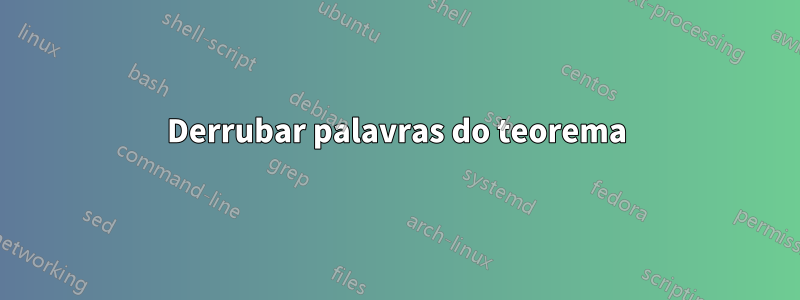
Eu tenho um teorema que é assim:
\documentclass[12pt]{book}
\begin{document}
\newtheorem{definition}{Definition}[section]
\begin{definition}[Integers]
Integers are positive and negative whole numbers, including 0.\\
e.g. $..., -3, -2, -1, 0, 1, 2, 3, 4, ...$
\end{definition}
\end{document}

Como faço para que a afirmação "Inteiros são positivos e negativos..." desça uma linha?
Eu tentei \\ mas isso criará um erro no line to end e também não derrubará o "Inteiros são positivos e negativos...".
Obrigado!
Responder1
Você pode usar amsthme definir seus próprios estilos de teoremas.
\documentclass[12pt]{book}
\usepackage{amsthm,amsmath}
\newtheoremstyle{breakthm}
{\topsep}% Space above
{\topsep}% Space below
{\itshape}% Body font
{}% Indent amount (empty = no indent, \parindent = para indent)
{\bfseries}% Thm head font
{.}% Punctuation after thm head
{\newline}% Space after thm head: " " = normal interword space;
{}% Thm head spec (can be left empty, meaning `normal')
\newtheoremstyle{breakdef}
{\topsep}% Space above
{\topsep}% Space below
{\upshape}% Body font
{}% Indent amount (empty = no indent, \parindent = para indent)
{\bfseries}% Thm head font
{.}% Punctuation after thm head
{\newline}% Space after thm head: " " = normal interword space;
{}% Thm head spec (can be left empty, meaning `normal')
\theoremstyle{breakthm}
\newtheorem{theorem}{Theorem}[section]
\theoremstyle{breakdef}
\newtheorem{definition}[theorem]{Definition}
\begin{document}
\begin{definition}[Integers]
Integers are positive and negative whole numbers, including $0$,
e.g.
\[
\dots, -3, -2, -1, 0, 1, 2, 3, 4,\dotsc
\]
\end{definition}
\begin{theorem}
The integers are useful.
\end{theorem}
\end{document}

Na minha opinião, isso é apenas uma perda de espaço.
Observe que isso amsthmoferece possibilidades de personalização muito melhores. Com theorem(ou melhor, ntheorem) você tem que definir um novo estilo de teorema se quiser que a fonte do corpo nas definições esteja na vertical, o que é habitual.
Outra possibilidade é usar thmtools, que facilita bastante a definição de novos estilos de teoremas. O mesmo que antes pode ser obtido com
\documentclass[12pt]{book}
\usepackage{amsmath,amsthm,thmtools}
\declaretheoremstyle[
postheadspace=\newline,
bodyfont=\itshape,
]{breakthm}% main style
\declaretheoremstyle[
style=breakthm,
bodyfont=\normalfont,
]{breakdef}% override the bodyfont
\declaretheorem[
name=Theorem,
style=breakthm,
numberwithin=section,
]{theorem}
\declaretheorem[
name=Definition,
style=breakdef,
numberlike=theorem,
]{definition}
\begin{document}
\begin{definition}[Integers]
Integers are positive and negative whole numbers, including $0$,
e.g.
\[
\dots, -3, -2, -1, 0, 1, 2, 3, 4,\dotsc
\]
\end{definition}
\begin{theorem}
The integers are useful.
\end{theorem}
\end{document}
Responder2
Existem muitos pacotes para personalizar teoremas, inclusive theoremna distribuição principal do latex:
\documentclass[12pt]{book}
\usepackage{theorem}
\theoremstyle{break}
\newtheorem{definition}{Definition}[section]
\begin{document}
\begin{definition}[Integers]
Integers are positive and negative whole numbers, including 0.\\
e.g. $..., -3, -2, -1, 0, 1, 2, 3, 4, ...$
\end{definition}
\end{document}


